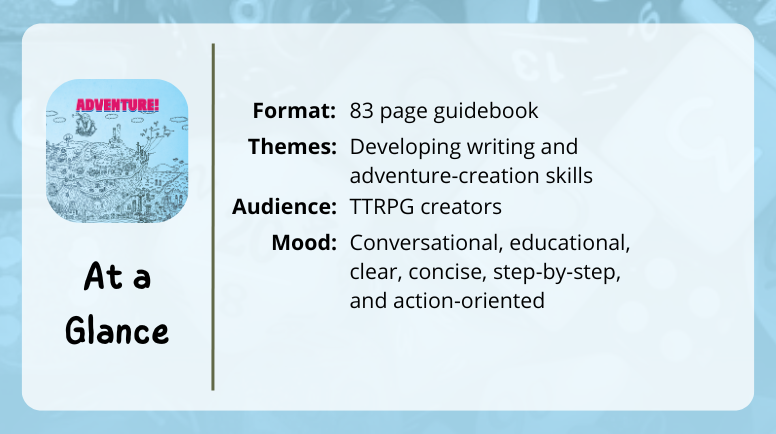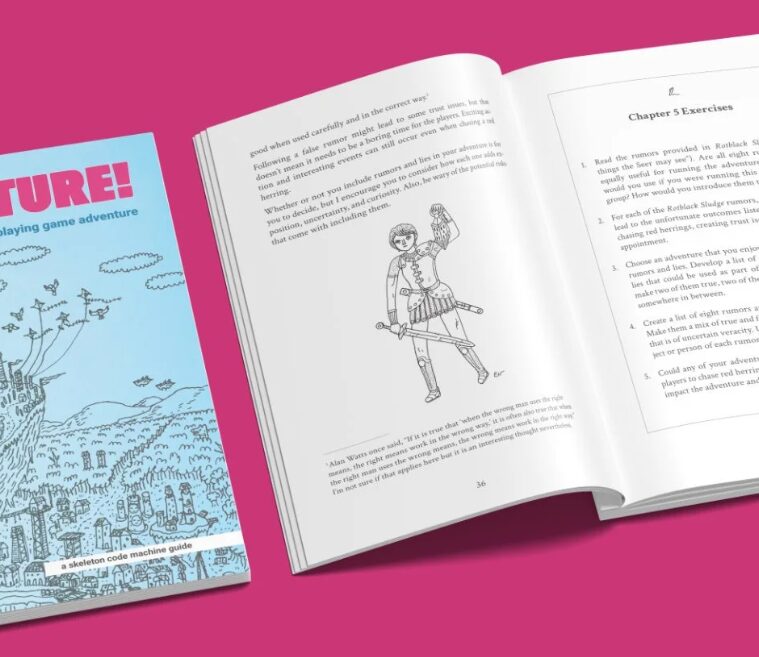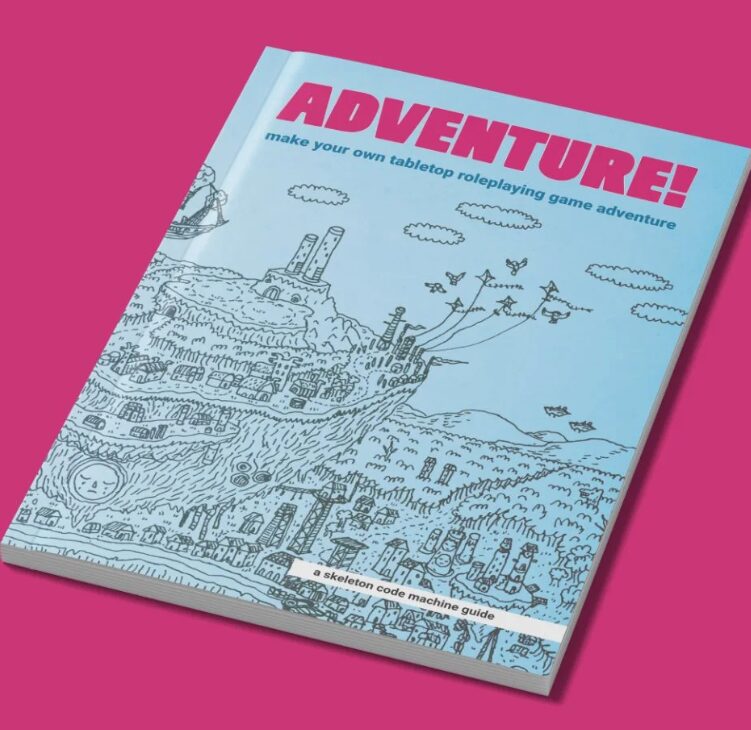Review of Adventure! – a guide to adventure-making essentials
Want to write your first TTRPG adventure but don’t know where to start? Or maybe you’ve already written a few and want to see a different method? Check out Adventure! from Skeleton Code Machine for a clear process and plenty of inspiration for your next writing endeavor!
Jump to:
- What is Adventure! about?
- Who would Adventure! be great for?
- How does Adventure! teach you to write your own scenarios?
- Overall thoughts on Adventure!
- Find a copy of Adventure!

What is Adventure! about?
Adventure! is a guidebook that walks you through the process of writing a tabletop role-playing game adventure, from plot hook to encounters, while integrating elements of world-building, player motivation, and fun to keep the story interesting during use.
This book also explains various considerations for publication and sharing during relevant steps of the process and gives tips, examples, and creative exercises to both explain the material and move you from the reading phase to the doing phase.

Who would Adventure! be great for?
Adventure! is a fantastic read for folks who are new to TTRPG writing and want to get a clear step-by-step process that encourages you to adjust it to fit your own ideas. Everything is laid out in a logical, concise, and focused manner that feels conversational and encouraging, making it easy to follow and enact.
It is also great for seasoned creators who could maybe use a bit of a break from their own process or who want to level up their writing by learning from others.
I publish my own games and have my own process, but, before reading this, I was legitimately starting to feel like I was getting into a rut or needed to try something a bit different.
This guide did a couple things for me while I was in that headspace.
First, it helped me to reconnect with certain parts of my process that lined up with what was in Adventure! by seeing them explained from a different perspective. It was a bit of a refresh and gave me a feeling for what parts of my own process I probably want to stick with because they re-resonated with me as I was reading this book… and I can also see how I might want to adjust a couple of those processes slightly, keeping the general concept the same but putting a different spin on it.
Second, it helped me to get new ideas for different ways to structure my processes AND to try out steps that I hadn’t really considered before, or that I maybe hadn’t separated from other steps. The best example I have for this is the rumors section in Adventure! – this was a really creative way to introduce plot points and create some mystery with information in the game. I’d seen this used before, but I hadn’t actually had that method broken down for me like this, and now I’m very curious to use this with some adjustments for my players (who are kids and might not like a totally false rumor, but who might be interested in a solid mix of half-truths).
The important thing here is that it challenged some of my own methods at a time when I needed it, so, don’t think that just because you have already published something, you don’t need a guidebook. Learning from others is incredibly important as you grow with your writing, and this is a solid method from a creator who is good at explaining his process.

How does Adventure! teach you to write your own scenarios?
Adventure! teaches you how to write by breaking the adventure-creation process down into manageable steps, explaining each step with examples alongside the lesson, and then giving you assignments, challenges, and questions to help you get moving.
I’ve mentioned how impactful the rumors section of the book was for me, but I also want to shout out how the encounters section emphasizes use of variety while giving you plenty of prompts and tips for making interesting events… and showcasing references to look up.
The monsters section gives actionable advice on how to make meaningful creatures AND shows how to make some cool NPCs. The relationship tree shown there was a method that I have used as a sketch on the side for some of my own writing, but that I now want to incorporate as a diagram in the published version of a future game because it got me to see how helpful that visual was when I wasn’t the one coming up with the characters myself. Not only did it showcase how to more easily create memorable characters, it highlighted a useful tool in a new way.
There’s dozens of other critical points for myself that I have noted; in the interest of not recapping the WHOLE book, I will say, it contains solid advice and teaches you through both explanation and demonstration, used in tandem.
In addition, at the end of each chapter, there is a set of short assignments that push you to take action. They give you an example or some research to check out, prompt you to experiment with the content and your ideas in a few ways, then pose a reflection question.
And I think this is REALLY important.
It moves the reader from being a reader to being a doer, which is sometimes a massive hurdle to overcome when starting a creative project. That act of beginning to write can feel like the a big commitment, but this method gives you small and approachable tasks to complete. It gets you to answer a question that moves you into the next step of the process instead of just telling you to start. It feels like a conversation, which can sometimes be easier to engage with.
It also structures itself to give multiple points of interactive connection with the material that you just read so it sticks. If you only read the book, maybe you’d remember a few key points, but, if you immediately use what you learn to start writing, researching, and pondering, that interaction internalizes it a bit more, and the concepts lock in. It gets the good material to also be effective via retention.

Overall thoughts on Adventure!
For me, Adventure! was a wonderful read that sparked some new ideas and inspirations for my own writing. I believe that it is an excellent guide for first time TTRPG writers and veterans alike due to its thoroughness, logical process, conversational tone, and motivating style. Adventure! is a guidebook that draws from clear experience with the vibe of an understanding teacher, and I highly recommend you check it out for kicking off that new idea or refreshing your existing methods!
Find a copy of Adventure!
You can find a copy of Adventure! on the Skeleton Code Machine/Exeunt Press website here!
If you liked this post, make sure to subscribe to the TTRPGkids monthly newsletter to stay up to date on the latest reviews, tips and tricks, game and podcast list updates, and more! Thank you for playing tabletop RPGs with your kids and sharing this awesome hobby with the next generation!


